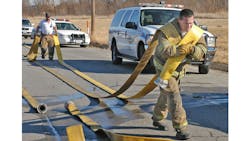"Engine 1 to Engine 2, lay in to us, we need a water supply."
When you hear this transmission over your radio, do you think, “Here we go, we will have to rack the 5-inch hose again”? Many of the fire departments around the country have switched their supply lines from 3-inch and went to the larger diameter hose. By doing so, we have given ourselves the option of large amounts of water.
Let me ask, do we really need 5-inch hose on all our fires? Isn’t it overkill on a room and contents fire? The answers are no we don't and yes it is overkill on some fires, but we have limitations on the amount of hosebed space we have and by laying out the LDH it gives us the needed water supply if the room and contents continues into a well-involved structure fire.
Using this larger, heavier hose can be challenging in many ways. From blocking out incoming apparatus to the inability to move it, we need to understand the impact of the LDH when it comes of our trucks and when it goes back on. Working with this size line takes additional manpower and some understanding of how to use it effectively. Let’s take a look at using this massive hose and how we should adjust for its use.
Once it’s down — If we are assigned the role of driver/operator or first-arriving officer, we need to understand that once this LDH is put on the ground it’s going to stay there. Having this understanding should allow you to make some choices up front:
- Ladder goes first
- Allowing for pressure release after the fire
If you choose to lay in the 5-inch and it lays down the middle of the road, you may have isolated yourself from an arriving ladder company, no matter if the hose is full of water or not. Some vehicle axles will not clear the LDH couplings and, in this case, you just created a lonely space. Finding out if the trucks will clear is a simple task that can be established back at the station. Lay out some hose and drive over it with the axle perpendicular to the hose. Keep the lowest point of the axle directly over top of the coupling. As you drive slowly over it, have someone stand behind the apparatus, out of the driving path, and watch it closely to see if it clears. If you take the time to establish this before you lay out, you will have an understanding that you are blocking out the truck.
When you charge the big lines you are being supplied a large amount of water. With this water comes pressure if you lay it out with elevation changes. Whether it’s laying it uphill or downhill, we need to set up our connection with a way to release this pressure once the fire is over. If the hydrant is on the downhill side of 1,000 feet of LDH, you can imagine the pressure exerted by that amount of water. If you fail to place the gate valve, you will have a hard time getting unhooked from the hydrant. I’m sure all of us at some point and time have forgotten to put the gate on the 2 1/2-inch valve. Ensuring that it is placed correctly is important for removal and it also gives you the options of using that outlet without turning off the hydrant.
Racking the LDH — When using the LDH, we all understand that it goes up much harder than it comes off. Numbers matter when placing it back in the bed. Let's use some simple math: two in the bed, two on the tailboard, and three pulling is the most efficient way to get it back on board. Now, we all know that finding that many firefighters to load hose can be difficult. How do we manage to load it properly with a lower number of firefighters? Simple, work smarter, not harder. Taking extra time and using three firefighters you can make it look good and pull straight. One firefighter in the bed, one on the tailboard, and a pulling firefighter can be successful in loading this large hose. It just takes patience and some changing of locations to ensure that not one firefighter is being overworked.
It all starts with the breakdown of the hose. Leaving it attached to the truck or hydrant and not allowing the massive amounts of air to enter will make the loading process much less taxing. Many firefighters forget this simple step and break down each section individually. While you may break them down this way, a simple hose cap can prevent the air from entering. Draining from the attached side or capped side towards the open end can create a vacuum that pushes the water out while keeping the air to a minimum. If the hose becomes filled with air, it will become much harder to lay flat.
Conclusion
No matter what our opinions are on using this larger-sized hose, we need to continually train with it. It’s not going anywhere soon. Laying out the big stuff gives you enough water to transition from offensive to exposure control with master streams without missing a beat. We should take the time to adjust how we approach its use and plan ahead for when it hits the ground.






